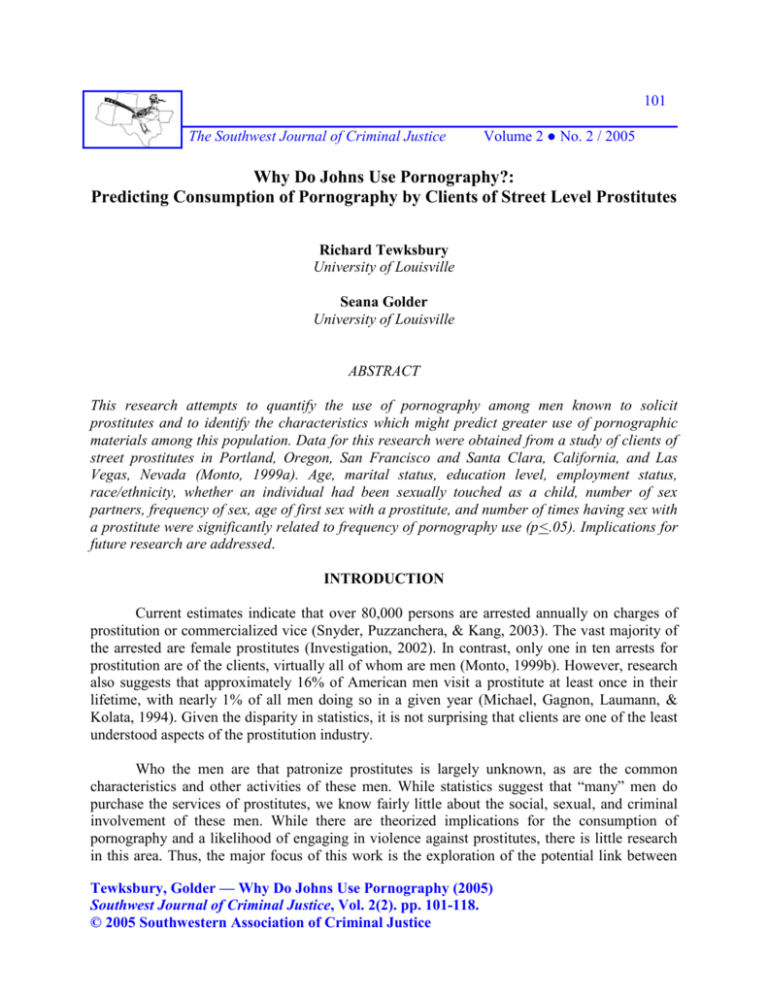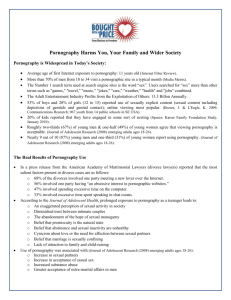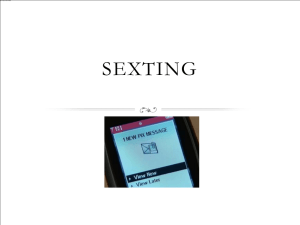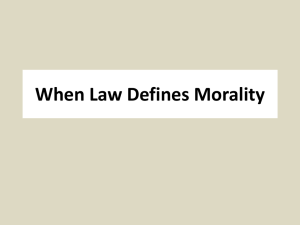
101
The Southwest Journal of Criminal Justice
Volume 2 ● No. 2 / 2005
Why Do Johns Use Pornography?:
Predicting Consumption of Pornography by Clients of Street Level Prostitutes
Richard Tewksbury
University of Louisville
Seana Golder
University of Louisville
ABSTRACT
This research attempts to quantify the use of pornography among men known to solicit
prostitutes and to identify the characteristics which might predict greater use of pornographic
materials among this population. Data for this research were obtained from a study of clients of
street prostitutes in Portland, Oregon, San Francisco and Santa Clara, California, and Las
Vegas, Nevada (Monto, 1999a). Age, marital status, education level, employment status,
race/ethnicity, whether an individual had been sexually touched as a child, number of sex
partners, frequency of sex, age of first sex with a prostitute, and number of times having sex with
a prostitute were significantly related to frequency of pornography use (p<.05). Implications for
future research are addressed.
INTRODUCTION
Current estimates indicate that over 80,000 persons are arrested annually on charges of
prostitution or commercialized vice (Snyder, Puzzanchera, & Kang, 2003). The vast majority of
the arrested are female prostitutes (Investigation, 2002). In contrast, only one in ten arrests for
prostitution are of the clients, virtually all of whom are men (Monto, 1999b). However, research
also suggests that approximately 16% of American men visit a prostitute at least once in their
lifetime, with nearly 1% of all men doing so in a given year (Michael, Gagnon, Laumann, &
Kolata, 1994). Given the disparity in statistics, it is not surprising that clients are one of the least
understood aspects of the prostitution industry.
Who the men are that patronize prostitutes is largely unknown, as are the common
characteristics and other activities of these men. While statistics suggest that “many” men do
purchase the services of prostitutes, we know fairly little about the social, sexual, and criminal
involvement of these men. While there are theorized implications for the consumption of
pornography and a likelihood of engaging in violence against prostitutes, there is little research
in this area. Thus, the major focus of this work is the exploration of the potential link between
Tewksbury, Golder — Why Do Johns Use Pornography (2005)
Southwest Journal of Criminal Justice, Vol. 2(2). pp. 101-118.
© 2005 Southwestern Association of Criminal Justice
Tewksbury, Golder – Why Do Johns Use Pornography – (2005)
102
patronizing prostitutes, consuming pornography, and sexually violent activities. Secondarily, this
research also seeks to provide greater understanding of the demographic and personal
background characteristics, as well as the non-violent sexual activities of men known to solicit
prostitutes. As such, this research offers the potential to inform public policy by providing a
profile of presumably highly sexual, and as previous research suggests, potentially violent men.
LITERATURE REVIEW
The research literature on clients of prostitutes is limited. The sparse ethnographic
research that is available has suggested that men who patronize prostitutes are not significantly
different from men in general (Armstrong, 1978; Holzman & Pines, 1982; Tewksbury & Gagne,
2002). One distinguishing trait of prostitutes’ customers, however, is that they have been shown
to hold more traditional (i.e., patriarchal) views of women, and perceive an entitlement for power
and control (Busch, Bell, Hotaling, & Monto, 2002).
Customers of prostitutes are often regulars, are usually employed, hold at least a high
school education, and more often than not are involved in a long term relationship (Atchison,
Fraser, & Lowman, 1998; Diana, 1985; McKegany & Barnard, 1996; Sawyer, Rosser, &
Schroeder, 1998; Sullivan & Simon, 1998; Campbell, 1998). And while sexual activity is typical
to the encounter between prostitute and customer, it is not necessarily the only or primary goal of
the customer (McKegany & Barnard, 1996; Sawyer et al., 1998; Winick, 1962).
It is also important to note that violence against female prostitutes by their customers is
well documented (Davis, 1993; Farley & Barkan, 1998; Horgard & Finstad, 1992; Miller, 1993;
Miller & Schwartz, 1995; Silbert, 1988). However, it appears that a small minority of customers
are responsible for perpetrating this violence. One recent study reported a relationship between
greater use of pornographic videos and endorsement of violence among men who solicited sex
from prostitutes (Monto, 1999b), although the majority (70%) of men patronizing prostitutes
only rarely or never consume pornography. Specifically, two pornography use variables (having
looked at pornographic magazines and having looked at pornographic video) were significantly
related to both an attraction to violent sex and having previously used violence to obtain sex
(Busch et al., 2002; Monto, 2000, 2001; Monto & Hotaling, 2001).
To date, the most ambitious and informative work on customers of prostitutes is that of
Monto and colleagues (Busch et al., 2002; Monto, 2000, 2001; Monto & Hotaling, 2001). This
research focused on providing a broader, more generalizable understanding of the background
characteristics, behaviors, and motivations of men arrested for soliciting prostitution. Data were
collected from 1,342 men in First Offender programs in California, Oregon, and Nevada. First
Offender programs focus on the “demand side of the equation”, holding male customers
responsible for their actions. These programs offered men the opportunity to voluntarily
participate in a deferred adjudication program following an arrest for attempting to hire a female
prostitute. Although the demographic characteristics and motives of prostitutes’ customers have
been documented, as well as their views and values related to gender relations, there has not been
significant research on the social backgrounds and corollary sexual (including sexually violent)
The Southwest Journal of Criminal Justice, Vol. 2(2)
103
behaviors and activities of these men. The present study is a move in this direction. Beginning to
address this gap will both help to facilitate our understanding of men who patronize prostitutes,
and to better understand the experiences and characteristics that these men bring to their
interactions with prostitutes. Given the dearth of available information on male clients of
prostitutes, this study, by necessity, is exploratory in nature and presents initial steps in this
direction.
METHODS
Data and Respondent Characteristics
This research is based on secondary data, publicly available from the Inter-university
Consortium for Political and Social Research (ICPSR - http://www.icpsr.umich.edu/index.html).
These data were originally collected in a study of clients of street prostitutes in Portland, Oregon,
San Francisco and Santa Clara, California, and Las Vegas, Nevada. Data were collected from
1997 to 1999 (Monto, 1999a). The original study employed a convenience sample of 1,342
respondents who were recruited from participants in client intervention programs for men
arrested trying to hire street prostitutes in these four cities. Participation in the study was
voluntary. Questionnaires were self-administered prior to the start of the intervention program
and collected anonymously (Monton and Hotaling, 2001). The response rate for the study was
over 80 % (Monto, 1999a, 1999b).
Measures
Five types of measures are described in the following section: demographic
characteristics, personal background characteristics, general sexual behavior, sexually aggressive
behavior, and frequency of pornography use.
The demographic characteristics that were assessed included age, marital status,
race/ethnicity, education level, and employment status. Respondents were requested to list their
age in years. Marital status was assessed with three categories: currently married, divorced,
widowed, or separated, or never married. Respondents were asked to choose the racial/ethnic
category that best described them (white, African American, Hispanic, Asian, or other).
Education level was also measured by a categorical variable assessing the participant’s highest
level of educational achievement: high school diploma or less, some college, or received either a
bachelor’s or master’s degree. Work status was a dichotomous variable reflecting whether a
respondent was working full or part time (1) or not (0).
Personal background characteristics were measured by four dichotomous variables (no
(0) or yes (1)). Respondents were asked if their parents were divorced, if they had ever been
touched sexually as a child, if they had ever been physically hurt as a child, and if they had
served in the military.
Tewksbury, Golder – Why Do Johns Use Pornography – (2005)
104
Respondents’ general sexual behavior was measured by six variables assessing: sexual
orientation, number of sex partners during the last 12 months, frequency of sex during the last 12
months, age when they first had sex with a prostitute, and number of times they reported having
sex with a prostitute during the last 12 months. Sexual orientation was measured on a continuum
from straight (1) to gay (5), bisexual, (3) was the midpoint. Respondents were asked to report the
number of sex partners they had in the past 12 months on a 9-point scale: 0 (0) to 4 (4), 5-10
partners (5), 11-20 partners (6), 21-100 (7), more than 100 partners (8). Response options for the
question asking participants about the frequency of sex during the past 12 months were given on
a eight point scale: not at all (1), once or twice (2), about once a month (3), 2 or 3 times a month
(4), about once a week (5), 2 or 3 times a week (6), greater than 3 times a week (7), don’t know
(8). Response options for the question assessing the frequency with which participants reported
having sex with a prostitute in the past year were never (1), only one time (2), more than 1 time
but less than once per month (3), 1 to 3 times per month (4), once or twice per week (5), 3 to 4
times per wk (6), 5 or more times per week (7).
Three questions were used as proxy measures of sexually aggressive behavior (Seto,
Maric, & Barbaree, 2001): threaten[ing] to use physical force to get sex, used physical force to
get sex, and the Rape Myth Acceptance Scale. The first two questions asked participants if they
had “ever had sexual intercourse with a woman when she didn't want to because you threatened
to use physical force (twisting her arm, holding her down, etc.) if she didn't cooperate?” or if
they had “used some degree of physical force” to make her have sexual intercourse; both
questions used a dichotomous response scale (yes [1]; no [0]). The Rape Myth Acceptance Scale
is an eight item scale that reflects the participant’s level of endorsement or acceptance of myths
about rape. In general rape myths are defined as “prejudicial, stereotyped, or false beliefs about
rape, rape victims, and rapists” (Burt, 1980; Tewksbury & Adkins, 1992) and serve “to justify or
support sexual violence against women and diminish support for rape victims”(Monto, 2001)).
Representative items include: “what percentage of women who report a rape would you say are
lying because they are angry and want to get back at the man they accuse?” (almost all (1), about
¾ (2), about half (3), about ¼ (4), almost none (5)), and “a woman who goes to the home or
apartment of a man on their first date implies that she is willing to have sex.” (agree strongly (1)
to disagree strongly (4)). Following coding instructions provided by Monto and Hotaling (2001),
responses were converted to z scores and then summed to create a total-scale score. The alpha
reliability for this sample was .83.
Frequency of Pornography Use. Frequency of pornography use was computed by taking
the mean of two questions assessing the frequency with which respondents reported looking at
pornographic magazines and watching pornographic videos. Response options for each of these
questions ranged from never (0) to several times a day (5). The computed variable reflecting the
frequency of pornography use had a possible range of 0 to 5.
Missing Data
Due to the presence of missing data within the dataset, we took steps to minimize the bias
to parameter estimates that can result from the more common methods of handling missing data
(e.g., listwise deletion and mean substitution, Graham, Hofer, Donaldson, Mackinnon, &
The Southwest Journal of Criminal Justice, Vol. 2(2)
105
Schafer, 1997; Graham, Hofer, & Piccinin, 1994). Thus the Mplus statistical analysis program
was used for all analyses (Muthen & Muthen, 2000). The Mplus program provides for the
handling of missing data through the use of a raw maximum-likelihood procedure to impute
values for missing data. Unbiased parameter estimates and reasonable standard errors are
obtained using the missing data feature in Mplus (Choi, Golder, Gillmore, & Morrison, 2005;
Muthen & Muthen, 2000).1
RESULTS
Analysis begins with presentation of the variables included in the analysis. Table 1
presents the descriptions of the variables, including their means, standard deviation of the mean,
and range (where appropriate). Specifics are reported below, according to groupings of variables,
including demographics, personal background, general sexual behavior, sexually aggressive
behavior and frequency of pornography use.
Table 1.
Means, standard deviation of the mean, and range of Demographic Characterisitics,
Personal Background Characteristics, General Sexual Behavior, Sexually Aggessive
Behavior, and Frequency of Pornography Use
Mean
(% for
categorical
variables)
Demographic Characteristic
Age
Marital status
Married
Divorced
Never Married
Race/ethnicity
White
African American
Hispanic
Asian
Other
37.853
S.D. of the
Mean
.311
Observed
Range
18-84
Observed
N
1248
42.2%
22.9%
34.9%
1313
57.8%
5.2%
20.0%
12.7%
4.3%
1 According to Choi et al. (2005; p. 31-32), “[Mplus is a statistical analysis package] that use[s] raw maximum-likelihood estimation (RML),
allowing for the handling of missing data during the actual statistical analysis (Arbuckle & Wothke, 1999; Muthén&Muthén, 1998)….
Maximum-likelihood estimates provide the correct likelihood for the unknown parameters (i.e., missing values) from the marginal distribution of
the observed data (Schafer&Graham, 2002). ML estimation requires data to be multivariate normal. Model fit, parameter estimates, and standard
errors are conveniently obtained by simply specifying within the programs that there are missing values in the data. Although analyses with RML
provide equally unbiased estimates as analyses with EM algorithm, the RML approach is slightly more efficient because it provides reliable
estimates of standard errors (Graham et al., 1997).” Readers interested in a full discussion of the benefits of RML and other newer techniques for
handling missing data are directed to Choi et al. (2005).
Tewksbury, Golder – Why Do Johns Use Pornography – (2005)
106
Table 1.
Means, standard deviation of the mean, and range of Demographic Characterisitics,
Personal Background Characteristics, General Sexual Behavior, Sexually Aggessive
Behavior, and Frequency of Pornography Use
Mean
(% for
categorical
variables)
Demographic Characteristic
Education level
2.77
H.S. Diploma or Less 28.9%
Some College 36.3%
Bachelor’s or Master’s 34.8%
Employment status
86.9%
Personal Background
Characteristics
Parents Divorced
34.5%
Touched Sexually as a Child
12.6%
Physically Hurt as a Child
13.2%
Military Service
24.9%
General Sexual Behavior
Sexual orientation
1.080
Number of sex partners
2.338
Frequency of sex
4.120
Age first sex with prostitute
1.817
# of times sex with prostitute
2.090
Sexually Aggressive Behavior
Threatened physical force for sex 1.10%
Used physical force for sex
0.80%
Rape Myth Acceptance Scale
-0.18
Frequency of pornography use 1.052
S.D. of the
Mean
Observed
Range
Observed
N
.033
1329
.009
1302
.013
.009
.009
.012
1275
1283
1277
1279
.011
.051
.048
.036
.031
1283
1321
1268
1272
1308
.003
.003
.110
.025
1279
1276
1139
1316
-15.03-9.47
0-5
Demographic Characteristics
As shown in Table 1, respondents report a wide range of ages, with a mean of 38. The
majority of respondents were white (57.8%). In regards to marital status, respondents most
frequently reported being married (42.2%), and educationally reported either some college
(36.3%) or at least a bachelor’s degree (34.8%).
Personal History
Just over one-third (34.5%) of the respondents reported that their parents were divorced.
One in eight (12.6%) reported being touched sexually as a child and 13% reported being
The Southwest Journal of Criminal Justice, Vol. 2(2)
107
physically hurt as children. Additionally, one-quarter (24.9%) of the respondents reported either
currently or in the past having served in the military.
General Sexual Behavior
The vast majority of respondents (90%) identified as exclusively heterosexual. Given the
lack of variability in sexual orientation, this variable was excluded from further analysis. Most
frequently, respondents reported having one (36.8%) or two (16.4%) sexual partners in the last
12 months. Slightly more than 20% of respondents reported having sex two or three times a
month during the past 12 months, although approximately 18% and 17%, respectively, reported
having sex either once a week or two or three times a week. Approximately 40% of the
respondents indicated that they had not had sex with a prostitute in the past twelve months. Most
commonly (48%), men reported that they had either had sex with a prostitute only one time, or
more than one time, but less than once per month in the past year.
Sexually Aggressive Behavior
An extremely low frequency of reported use of threats or actual violence for purposes of
obtaining sex was reported. Only 14 and 11 respondents, respectively, indicated that they had
used either threats of or actual violence to get sex (eight respondents replied they had used both).
Consequently, as with sexual orientation, questions assessing whether a respondent had used
threats of or actual violence to get sex were excluded from further analysis due to lack of
variability. Additionally, there was very little endorsement of rape myths within the sample (see
Monto & Hotaling, 2001).
Frequency of Pornography Use
Twenty five percent of the sample reported never using pornography, and approximately
90% of the respondents who did report using pornography claimed to do so less than once a
month.
Exploratory Analysis
The analysis was conducted in two steps. In the first step, regression analysis was used to
examine the relationship among all the hypothesized predictors (e.g., demographic
characteristics, personal background characteristics, general sexual behavior, and the Rape Myth
Acceptance Scale), and the dependent variable, frequency of pornography use. Categorical
variables were dummy coded. For marital status, individuals who reported being married were
treated as the comparison group (group assigned zero’s throughout). White was the comparison
group for race/ethnicity. The comparison group for education level was having a high school
diploma or less. Not working full or part-time was the comparison group for employment status.
All the predictors were entered into the equation simultaneously.
Tewksbury, Golder – Why Do Johns Use Pornography – (2005)
108
Table 2 displays the regression coefficients for the model. Overall, the variables in the
model explained 14% of the variance in pornography use. Age, whether an individual had been
sexually touched as a child, number of sex partners during the last 12 months, frequency of sex
during the last 12 months, age of first sex with a prostitute, and number of times reported having
sex with a prostitute during the last 12 months, were significantly related to frequency of
pornography use (p<.05). The variables that failed to make a significant contribution included
whether an individual’s parents were divorced, whether they had been physically hurt as a child,
had served in the military, and the Rape Myth Acceptance Scale.
Table 2.
Regression Model
Z Statistica
b
SE
Beta
Age
-.011*
.003
-4.247
-.142
Divorced
Never Married
.055
.144*
.062
.061
0.884
2.360
.026
.076
African American
Hispanic
Asian
Other
-.033
.114
.213*
-.139
.108
.067
.076
.118
-0.303
-1.692
2.793
-1.174
-.008
-.051
.079
-.031
Some College
.198*
.060
3.325
Bachelor’s or Master’s
.249*
.062
3.988
Employment Status -.176*
.071
-2.461
Parents Divorced
.037
.052
0.708
Touched Sexually as a Child
.180*
.074
2.442
Physically Hurt as a Child
.044
.073
0.599
Military Service
.091
.058
1.567
Number of sex partners
.035*
.017
2.107
Frequency of sex
.042*
.015
2.741
Age first sex with prostitute
.058*
.020
2.846
# of times sex with prostitute
.113*
.027
4.244
Rape Myth Acceptance Scale
.010
.007
1.374
a Significant at p< .05 with value equal to or greater than 1.96; R 2 = .140.
.106
.132
-.066
.019
.066
.017
.044
.073
.081
.082
.141
.040
Variable
Marital status
Race/ethnicity
Education level
Significant test statistics for the regression coefficients for the dummy coded variables
are equivalent to a test of difference between the mean of the group identified by the vector and
the comparison group (e.g. white, the comparison group, and African American, the group
identified by the vector). Examination of the regression coefficients for the dummy coded
variables in the model suggest that frequency of pornography use also varied as a function of
group membership (i.e., results presented in Table 2 indicate that there were significant findings
The Southwest Journal of Criminal Justice, Vol. 2(2)
109
for participants that reported never being married, Asian, having some college, and a Bachelor’s
or Master’s degree, respectively).
Given that significant results were found for group membership, as defined by marital
status, race/ethnicity, educational level, and employment status, respectively, the second step of
the analysis involved further examination of the relationship between group membership and
frequency of pornography use. As in the first step of the analysis, a series of regressions were
conducted to examine the relationship among the hypothesized predictors and frequency of
pornography use - defined by group membership. To have the most parsimonious models
possible, variables that failed to yield a significant relationship with frequency of pornography
use in the first step of the analysis were excluded from subsequent models. The removal of these
variables did not change the pattern of estimated coefficients. Results of these regressions as well
as the average frequency of pornography use (as described above, frequency of pornography use
was measured on a 0 [never] to 5 [several times a day scale]) for each subgroup are presented in
Table 3.
Table 3.
Relationship among the hypothesized predictors and frequency of pornography use defined by group membership.
Variable
Mean Freq. of Porn. Use
Marital status
Married (n=560)
Divorced (n=304)
Never Married (n=464)
.945
1.029
1.195
b
SE
Beta
b
SE
Beta
b
SE
Beta
-.004
.003
-.049
-.014*
.005
-.161
-.007
.006
-.061
Touched Sexually
.036
.106
.014
.300*
.146
.114
.334*
.137
.113
# of Sex Partners
.015
.028
.031
.016
.036
.035
.094*
.028
.186
Freq. of Sex
.068*
.023
.132
.023
.034
.045
.021
.027
.040
Age Sex w/Prost.
.065*
.028
.105
.070
.039
.105
.071
.045
.082
# of Times w/Prost.
.115*
.043
.155
.176*
.054
.230
.068
.048
.078
Age
Tewksbury, Golder – Why Do Johns Use Pornography – (2005)
110
Table 3.
Relationship among the hypothesized predictors and frequency of pornography use defined by group membership.
Variable
Education Level
Mean Freq. of Porn. Use
HS Diploma or Less
(n=384)
.833
Some College
(n=482)
1.109
b
b
SE
Beta
SE
Bachelor’s or Master’s
(n=463)
1.173
Beta
b
SE
Beta
-.005
.004
-.073
-.015*
.004
-.190
-.012*
.004
-.138
Touched Sexually
.133
.137
.049
.179
.115
.069
.291*
.125
.108
# of Sex Partners
.055
.028
.116
.058*
.028
.118
.017
.029
.037
Freq. of Sex
.053*
.024
.120
.041
.026
.076
-.014
.028
-.025
Age Sex w/Prost.
.098*
.036
.143
.080*
.037
.109
.007
.033
.010
# of Times w/Prost.
.093
.048
.113
.080
.046
.100
.171*
.046
.225
Variable
Employment Status
Age
Mean Freq. of Porn. Use
Not Employed
(n=170)
1.130
b
SE
Employed (n=1132)
Beta
1.039
b
SE
Beta
Age
-.010*
.003
-.113
-.015*
.004
-.245
Touched Sexually
.136
.079
.051
.647*
.209
.224
# of Sex Partners
.046*
.018
.095
.117*
.045
.236
Freq. of Sex
.050*
.017
.096
-.046
.043
-.088
Age Sex w/Prost.
.079*
.023
.111
.017
.053
.024
# of Times w/Prost.
.091*
.030
.113
.152*
.068
.188
* Significant at p< .05 with value equal to or greater than 1.96.
The Southwest Journal of Criminal Justice, Vol. 2(2)
111
Table 3.
Relationship among the hypothesized predictors and frequency of pornography use defined by group membership.
Variable
Mean Freq. of
Pornography Use
Race/Ethnicity
White
(n=757)
1.082
African American
(n=68)
1.086
b
SE
Age
-.012*
.003
Touched Sexually
.147
# of Sex Partners
b
SE
Beta
-.147
.000
.010
.003
.095
.055
.179
.282
.078
.051*
.022
.110
-.116
.068
Freq. of Sex
.029
.021
.054
.077
Age Sex w/Prost.
.054*
.025
.082
# of Times w/Prost.
.086*
.035
.113
Variable
Race/Ethnicity
Mean Freq. of
Pornography Use
Beta
Hispanic
(n=264)
.871
Asian
(n=167)
1.264
b
Beta
-.013
.380*
.181
.131
-.252
.071
.037
.135
.063
.157
.062
.032
.129
.003
.086
.004
.037
.060
.040
.256*
.100
.348
.099
.068
.102
b
SE
Other
(n=57)
.858
SE
b
SE
.006
-.024*
.006
-.024*
.006
Touched Sexually
.274
.194
.274
.194
.274
.194
# of Sex Partners
.106*
.050
.106*
.050
.106*
.050
Freq. of Sex
-.001
SE
.007
-.024*
Age
b
-.042
.049
-.042
.049
-.042
.049
Age Sex w/Prost.
.091
.059
.091
.059
.091
.059
# of Times w/Prost.
.090
.082
.090
.082
.090
.082
The first step in the analysis indicated that respondents who reported never being married
were more frequent users of pornography than those who reported being married. Examination of
the regression coefficients for never married respondents in step 2 indicates that being touched
sexually as a child and the number of sex partners in the past 12 months are significantly related
to frequency of pornography use among this subgroup of men. Significant differences (in step 1)
were also found between respondents who had some college or a bachelor’s or master’s degree
and those with a high school diploma or less. Analysis revealed that age is inversely related to
frequency of pornography use for both men with some college and those with a bachelor’s or
master’s degree. In addition to age, number of sex partners and reported age when they first had
sex with a prostitute are significantly related to frequency of pornography use among men with
Tewksbury, Golder – Why Do Johns Use Pornography – (2005)
112
some college. Among men with bachelor’s or master’s degrees, being touched sexually as a child
and the number of times they have been with a prostitute are significant predictors of
pornography use.
There were also significant differences in pornography use between respondents based on
employment status. With the exception of being touched sexually, all the predictors were
significantly related to pornography use for men who reported not being employed full or parttime. For men who were employed, frequency of sex and age they first reported having sex with
a prostitute failed to yield a significant relationship with frequency of pornography use.
Finally, in regards to race/ethnicity, the initial regression model indicated that there was a
significant difference in frequency of pornography use between white and Asian men, with Asian
men having a higher frequency of pornography use than men in any other racial/ethnic group.
Examination of the regression coefficients in Table 3 indicates that only age and number of sex
partners were significantly related to pornography use among Asian respondents; age was
inversely related to pornography use.
DISCUSSION
Given the dearth of information regarding the male clients of female prostitutes, this
study was exploratory. In particular, we sought to explore the potential link between patronizing
prostitutes, consuming pornography, and sexually violent activities. Results indicated that
sexually aggressive behaviors among this sample were infrequent. Thus, within this sample, no
relationship was found between patronizing prostitutes, consuming pornography, and sexual
violence.
Somewhat surprisingly, in contrast to prior work and our own predictions, the Rape Myth
Acceptance Scale failed to reach significance (i.e., there was no relationship between
participants’ belief in rape myths and pornography use). A number of methodological issues may
have affected this particular finding. As stated above, this sample was generally well educated,
with over 70% reporting they had at least some college. The respondents, who already fall into a
stigmatized category (e.g. arrested johns), may have “seen through” the questions comprising the
Rape Myth Acceptance Scale, and responded in what they thought was a more socially
acceptable, less stigmatized way. Thus, biased responses may have attenuated any relationship
between the Rape Myth Acceptance Scale and frequency of pornography use.
Furthermore, although the Rape Myth Acceptance Scale was comprised of multiple items
and measured at the interval level, both the other measures of sexual aggression were single
items with dichotomous response options. Examination of the results indicated that there was a
relatively low frequency of affirmative responses to these questions and they were subsequently
dropped from further analyses. It may be that measures that are comprised of multiple items, that
survey a range of sexually threatening and violent behaviors, and record responses on a more
sensitive scale (i.e. interval level) may be more appropriate tools for assessing engagement in
sexually aggressive behavior. Notwithstanding, it is quite possible that among this particular
The Southwest Journal of Criminal Justice, Vol. 2(2)
113
population that there is relatively little relationship between pornography use and sexual
aggression. Further research employing more sensitive measures of sexual aggression is needed
to better understand the relationship between sexual aggression and pornography use among
male customers of female prostitutes.
Relatedly, there are many different types of pornography. The variables assessing
frequency of pornography use in the study from which these data were taken did not specify the
content of the pornographic material (e.g., depictions of forced sexual acts or more consensual
interactions). It is likely that there is significant variability among the sample in terms of their
preference in regards to the content, as well as delivery method (e.g., video, magazine, internet,
peep show, etc.) of pornographic material. Future studies incorporating more sensitive measures
of pornography use and variety may allow us to identify subgroups of pornography users and
differential predictors associated with these subgroups. For example, it may be that more
sexually aggressive men prefer pornography that depicts violence (Seto et al., 2001).
In addition to the focus on pornography and violence, we sought to develop a greater
understanding of the demographic and personal background characteristics, as well as the nonviolent sexual activities among the male clients of street level prostitutes. To this effect, our
analysis identified 10 variables that collectively account for 14% of the variance associated with
frequency of pornography use among this sample of street prostitutes’ clients. The variables that
were significant predictors of frequency of pornography use include all five of the tested
demographics, one of four personal background traits (whether an individual had been sexually
touched as a child), and four of the five assessed general sexual behavior variables (number of
sex partners during the last 12 months, frequency of sex during the last 12 months, age of first
sex with a prostitute, and number of times reported having sex with a prostitute during the last 12
months). The results indicated that age, the number of times respondents reported having sex
with a prostitute during the last 12 months, and educational level were associated with the largest
increases in frequency of pornography use. Thus, men who had sex more frequently with
prostitutes, who were more educated, and who were younger, were more frequent users of
pornography than other men in the sample.
Significant subgroup differences defined by demographic categories were also found to
be important correlates of frequency of pornography use. Never married men were more frequent
users of pornography than their married counterparts, as were men with higher levels of
education. Respondents who reported being unemployed were more frequent consumers of
pornography, as were Asian men. It is also important to point out that whether a respondent was
touched sexually as a child consistently appears to play a significant role in frequency of
pornography use for some groups of men (divorced and never married men, men with college
degrees and employed men). Clearly, having been sexually abused as a child plays a role in
frequency of pornography consumption; however, further research is needed to fully understand
this relationship.
Several limitations of the present work should be acknowledged. Although participation
was voluntary and the participation rate was 80%, participants were men arrested for soliciting
Tewksbury, Golder – Why Do Johns Use Pornography – (2005)
114
female prostitutes and participating in deferred adjudication programs (Monto, 1999a, 1999b).
As noted in Busch et al. (2002), “their attitudes may not be representative of male customers as a
whole. [Moreover,] the connection between attitudes and behaviors is not direct” (pg. 1109).
Although not a universally accepted position, a large body of research supports the reliability and
validity of self-report data (e.g. Darke, 1998; Hindeland, Hirschi, & Weis, 1981; Hser, 1993;
Lauritsen, 1998; Rouse, Kozel, & Richards, 1985). It is important to note that the study from
which these data were drawn relies heavily on respondents’ self-reports of socially undesirable
behaviors. Care should be taken in interpreting and generalizing these results as the sample may
not be fully representative of the population of clients of street prostitutes. Finally, it should be
acknowledged that this study examines correlates of behaviors. The time ordering of activities
can not be deduced from the data. Many of the predictors of pornography use could have
occurred contemporaneously to or after the use of pornography. Care must therefore be exercised
in interpreting findings.
It should be noted that a particular strength of the current study is our handling of missing
data. Prior published research utilizing these data has either failed to address this issue or used
mean substitution. This suggests that conclusions based on prior analyses may be significantly
biased (Choi et al., 2005; Graham et al., 1997; Graham et al., 1994). The current study imputed
missing data via a raw maximum-likelihood procedure allowing us to obtain unbiased parameter
estimates and reasonable standard errors (Choi et al., 2005; Muthen & Muthen, 2000). Thus,
conclusions based on the analyses reported here are done without the threats present in prior
studies with this data.
In conclusion, this was an exploratory study that sought to increase our understanding of
behavior among an understudied population: male customers of female, street level prostitutes.
Results of this research suggest that although pornography use may not be rampant among this
population, there are demographic, personal background, and general sexual behavior variables
that are predictive of pornography consumption. These results also call into question the veracity
of feminist claims regarding connections between pornography consumption, objectification of
women, and violence against women. Men who patronize street-level prostitutes are not
especially likely to be frequent consumers of pornography.
The Southwest Journal of Criminal Justice, Vol. 2(2)
115
REFERENCES
Armstrong, E. G. 1978. “Massage Parlors and Their Customers.” Archives of Sexual Behavior,
Volume 2, pp. 117-125.
Atchison, Chris, Fraser, Laura, & Lowman, John. 1998. “Men Who Buy Sex: Preliminary
Findings of an Exploratory Study” in G. Brewer (Ed.), Prostitution: On whores, hustlers, and
johns. Amherst, NY: Prometheus: pp. 172-203.
Burt, M. 1980. “Cultural Myths and Supports for Rape.” Journal of Personality and Social
Psychology, Volume 38, pp. 217-230.
Busch, N., Bell, H., Hotaling, N., & Monto, M. 2002. “Male Customers of Prostituted Women:
Exploring Perceptions of Entitlement to Power and Control and Implications for Violent
Behavior Toward Women. Violence Against Women, Volume 8(9), pp. 1093-1112.
Choi, Yoonsun, Golder, Seana, Gillmore, Mary Rogers, & Morrison, Diane. 2005. “Analysis
with Missing Data in Social Work Research.” Journal of Social Work Research, Volume 31 (3),
pp. 23-48.
Darke, S. 1998. “Self-Report among Injecting Drug Users: A Review.” Drug and Alcohol
Dependence, Volume 51, pp. 253-263.
Davis, N. 1993. Prostitutions: An International Handbook on Trends, Problems, and Policies.
London: Greenwood.
Diana, L. 1985. The Prostitute and Her Clients: Your Pleasure is Her Business. Springfield, IL:
Charles C. Thomas.
Farley, M., & Barkan, H. 1998. “Prostitution, Violence against Women, and Posttraumatic Stress
Disorder. Women & Health, Volume 27(3), pp. 37-49.
Federal Bureau of Investigation 2002. Uniform Crime Reports: Crime in the Unites States - TenYear Arrest Trends by Sex, 1993-2002. Washington D.C.: Federal Bureau of Investigation.
Graham, J. W., Hofer, S. M., Donaldson, S. I., Mackinnon, D. P., & Schafer, J. L. 1997.
“Analysis with Missing Data in Prevention Research” in S. West (Ed.), The Science of
Prevention: Methodological Advances from Alcohol and Substance Abuse Research. Washington
D.C.: American Psychological Association: pp. 325-366.
Graham, J. W., Hofer, S. M., & Piccinin, A. M. 1994. “Analysis with Missing Data in Drug
Prevention Research” in L. Seitz (Ed.), Advances in Data Analysis for Prevention Intervention
Research. Washington D.C.: National Institute on Drug Abuse: pp. 13-63.
Tewksbury, Golder – Why Do Johns Use Pornography – (2005)
116
Hindeland, M. J., Hirschi, T., & Weis, J. 1981. Measuring Delinquency. Beverly Hills, CA: Sage
Publications.
Holzman, H. R., & Pines, S. 1982. “Buying Sex: The Phenomenology of Being a John.” Deviant
Behavior, Volume 49, pp. 89-116.
Horgard, C., & Finstad, L. 1992. Back Streets: Prostitution, Money and Love. University Park,
PA: Pennsylvania State University Press.
Hser, Y.-I. 1993. “Data Sources: Problems and Issues.” Journal of Drug Issues, Volume 23(4),
pp. 217-229.
Lauritsen, Janet. 1998. “The Age-Crime Debate: Assessing the Limits of Longitudinal SelfReport Data.” Social Forces, Volume 77(1), pp. 127-154.
McKegany, N., & Barnard, M. 1996. Sex Work on the Streets: Prostitutes and Their Clients.
Buckingham, UK: Open University Press.
Michael, R., Gagnon, J., Laumann, E., & Kolata, G. 1994. Sex in America. Boston: Little, Brown
and Company.
Miller, Jody. 1993. “Your Life Is on the Line Every Night You're on the Streets: Victimization
and Resistance among Street Prostitutes.” Humanity and Society, Volume 17(4), pp. 422-446.
Miller, Jody & Schwartz, Martin. 1995. “Rape Myths and Violence Against Street Prostitutes.”
Deviant Behavior, Volume 16(1), pp. 1-23.
Monto, Martin. 1999a. Clients of Street Prostitutes in Portland, Oregon, San Francisco, and
Sanata Clara, California, and Las Vegas, Nevada, 1996-1999 [Computer file]. (Ann Arbor, MI:
Inter-university Consortium for Political and Social Research [distributor], 2000 ed.): Portland,
OR: University of Portland [producer].
Monto, Martin. 1999b. Focusing on the Clients of Street Prostitutes: A Creative Approach to
Reducing Violence Against Women - Summary Report (182859). Washington, D.C.: U.S.
Department of Justice.
Monto, Martin. 2000. “Why Men Seek Out Prostitutes” in R. Weitzer (Ed.), Sex for Sale:
Prostitution, Pornography and the Sex Industry. New York: Routledge: pp. 67-83
Monto, Martin. 2001. “Prostitution and Fellatio.” The Journal of Sex Research, Volume 38(2),
pp. 140-145.
Monto, Martin, & Hotaling, Norma. 2001. “Predictors of Rape Myth Acceptance among Male
Clients of Female Street Prostitutes.” Violence Against Women, Volume 7(3), pp. 275-293.
The Southwest Journal of Criminal Justice, Vol. 2(2)
117
Muthen, L., & Muthen, B. 2000. Mplus: The Comprehensive Modeling Program for Applied
Researchers. User's Guide Version 2.0. Los Angeles, CA: Muthen & Muthen.
Rouse, B., Kozel, N., & Richards, L. 1985. Self-Report Methods of Estimating Drug Use Meeting Current Challenges to Validity (NIDA Research Monograph 57): National Institute of
Drug Abuse.
Sawyer, S., Rosser, B. R. S., & Schroeder, A. 1998. “Brief Psychoeducational Program for Men
Who Patronize Prostitutes.” Journal of Offender Rehabilitation, Volume 26(3), pp. 111-125.
Seto, M., Maric, A., & Barbaree, H. 2001. The Role of Pornography in the Etiology of Sexual
Aggression.” Aggression and Violent Behavior, Volume 6, pp. 35-53.
Silbert, M. 1988. “Compounding Factors in the Rape of Street Prostitutes. In A. Burgess (Ed.),
Rape and sexual assault, II. New York: Garland Press: pp. 75-90.
Snyder, H., Puzzanchera, C., & Kang, W. 2003. Easy Access to FBI Arrest Statistics 1994-2001
[Online].
Retrieved
04/14/04,
2004,
from
the
World
Wide
Web:
http://ojjdp.ncjrs.org/ojstatbb/ezaucr/
Sullivan, Elroy, & Simon, William. 1998. “The Client: A Social, Psychological and Behavioral
Look at the Unseen Patron of Prostitution.” In G. Brewer (Ed.), Prostitution: On whores,
hustlers, and johns. Amherst, NY: Prometheus: pp. 134-154.
Tewksbury, Richard, & Adkins, Mark. 1992. Rape Myths and Emergency Room Personnel.
Response to the Victimization of Women and Children, Volume 14(4), pp. 10-15.
Winick, Charles. 1962. “Prostitutes' Clients' Perceptions of the Prostitutes and Themselves.”
International Journal of Social Psychiatry, Volume 8(4), pp. 289-299.
Tewksbury, Golder – Why Do Johns Use Pornography – (2005)
118
BIOGRAPHICAL SKETCHES
Richard Tewksbury is a Professor in the Department of Justice Administration at the University
of Louisville. He holds degrees in sociology from The Ohio State University. He is primarily
interested in issues of deviant behavior (crime, drug use/abuse, sexuality), men's studies and
qualitative methods. He is actively involved in a variety of research and service projects working
with correctional departments and institutions, police departments, and social service agencies.
Seana Golder is an Assistant Professor in the Kent School of Social Work at the University of
Louisville. She received her M.S.W from Louisiana State University and her Ph.D. in Social
Welfare from the University of Washington. Her primary research interests are around the issues
of women’s risk behavior (e.g., substance use, sexual risk, and lawbreaking) and involvement in
the criminal justice system.









